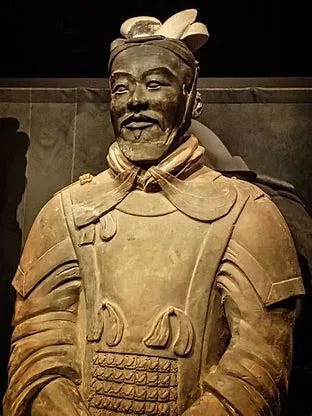Comparing: Confusing Events
The Art of War 9:5.42-49: Your enemy first acts violently and then is afraid of your larger force.
This post continues our project explaining each stanza of Sun Tzu’s work. The English translation and Chinese transliterations are from my award-winning book, The Art of War and The Ancient Chinese Revealed.
The topics discussed in this article are from the three ending stanzas of Section Five of Chapter 9 of The Art of War. These stanzas all describe competitive tactics that require sending mixed signals. On the surface, these mixed signals are all confusing but that confusion is part of a larger plot.
These three stanzas discuss situations where a competitor is threatening a “battle.” In non-military competitions, these “battles” are situations where we are brought into a direct comparison with an opponent so a decision can be made, choosing between alternative competitors. This decision decides the winner and losers of the battle.
In the lines below, we summarize each Chinese character with a single English word shown in < > brackets in their original order. This transliteration of the Chinese is followed by an English sentence translation.
The Violent and Fearful
<First> <violent> <and> <yet> <afterward> <fear> <this><crowd> <is>
Your enemy first acts violently and then is afraid of your larger force.<No> <select> <’s> <arrive> <also>
His best troops have not arrived.
“Violent” means engaging in a destructive form of competition. These are acts of conflict meant to damage opponent’s positions rather than to build up our own. This form of competition is designed to get a reaction from another competitor. Such attacks also focus the engagement on weaknesses in opposing positions. When others react, defending their positions, it gives the initiator an opportunity to display fear by running away and avoiding a decisive engagement.
This mixed message of displaying hostility and then showing fear is confusing. Emotion is a temporary condition, an aspect of the element of climate, but it also communicates a message. The initial aggression displays strength but the following fear communicates weakness. Which should be believed? Our tendency is to trust the current emotion because it has been informed by more recent information. However, the competitor initiating the confrontation knew that they would be at an initial disadvantage.
This tactic is only used when a direct comparison between opponents was eventually unavoidable. Its purpose is to delay that general comparison by giving opponents something to defend. The initiator creates a delay to give themselves time to bring in reinforcements for the general comparison. These reinforcements can take many different forms. In business, it could be a new ally, a new product, or something similar. The arrival of these new resources is expected to tip the advantage to the company initiating the delay.
Committee Negotiations
<Come> <committee> <thank> <is>
Your enemy comes in a conciliatory manner.<Desire> <rest> <breath> <also>
He needs to rest and recuperate.
In this situation, the initiating competitor seems to want to make peace, even possibly form an alliance. But this proposal is made by a group, a committee, rather than by the leader of the organization. A sincere desire for an alliance is almost always led and negotiated by leaders, not by parts of the organization’s bureaucracy who are never the final decision-makers.
This is a longer term delaying tactic when we need time to rebuild our resources. In the modern world, the use of “committees” or the bureaucracy is even more accepted than it was in Sun Tzu’s time. As with all bureaucracies, the negotiations regarding an alliance or any agreement will bog down, be delayed, and drag on. The opponent will even give positive signs, such as moving negotiations to a new committee, bigger or smaller, further up in their organization. Each committee is a new point of delay. Any committee worth its salt can cheerfully make requests for more information ad infinitum.
The use of committees in this ways is a sign that the opponent needs to delay competition. They are currently too weak to defend their territory.
Furious Competition
The last situation is a competitors who portrays themselves as very emotionally committed to expansion. They appear to welcome even destructive conflict.
<War> <fury> <and> <yet> <appears> <greet>
Your enemy is angry and appears to welcome battle.<Long> <time> <and> <yet> <no> <join>
This goes on for a long time, but he doesn’t attack.<Both> <no> <appear> <go>
He also doesn’t leave the field.<Must> <cautious> <examine> <it>
You must watch him carefully.
This competitor portrays him or herself as fiercely committed to expanding into the positions of other, ready to challenge others at any moment on any point of comparison. Because of this attitude, opponents take a defensive posture, one that defends every part of their positions. They are waiting to see who this dominating competitor is challenging next and how.
This aggressor, however, doesn’t make a move. They continue to build up their resources for expansion, but they show no signs of where they want to expand. Their potential opponents cannot know how to react to this. This desire for “war” can also be a tactic. This tactic puts others on defense. The initiator remains ready to attack. This keeps others on defense. This goes on for a long time because the purpose of the tactic is to wear down the opposition. The initiator is waiting until one of them relaxes or gets sloppy in defending their territory. At that point, this furious warrior will make his or her move.



